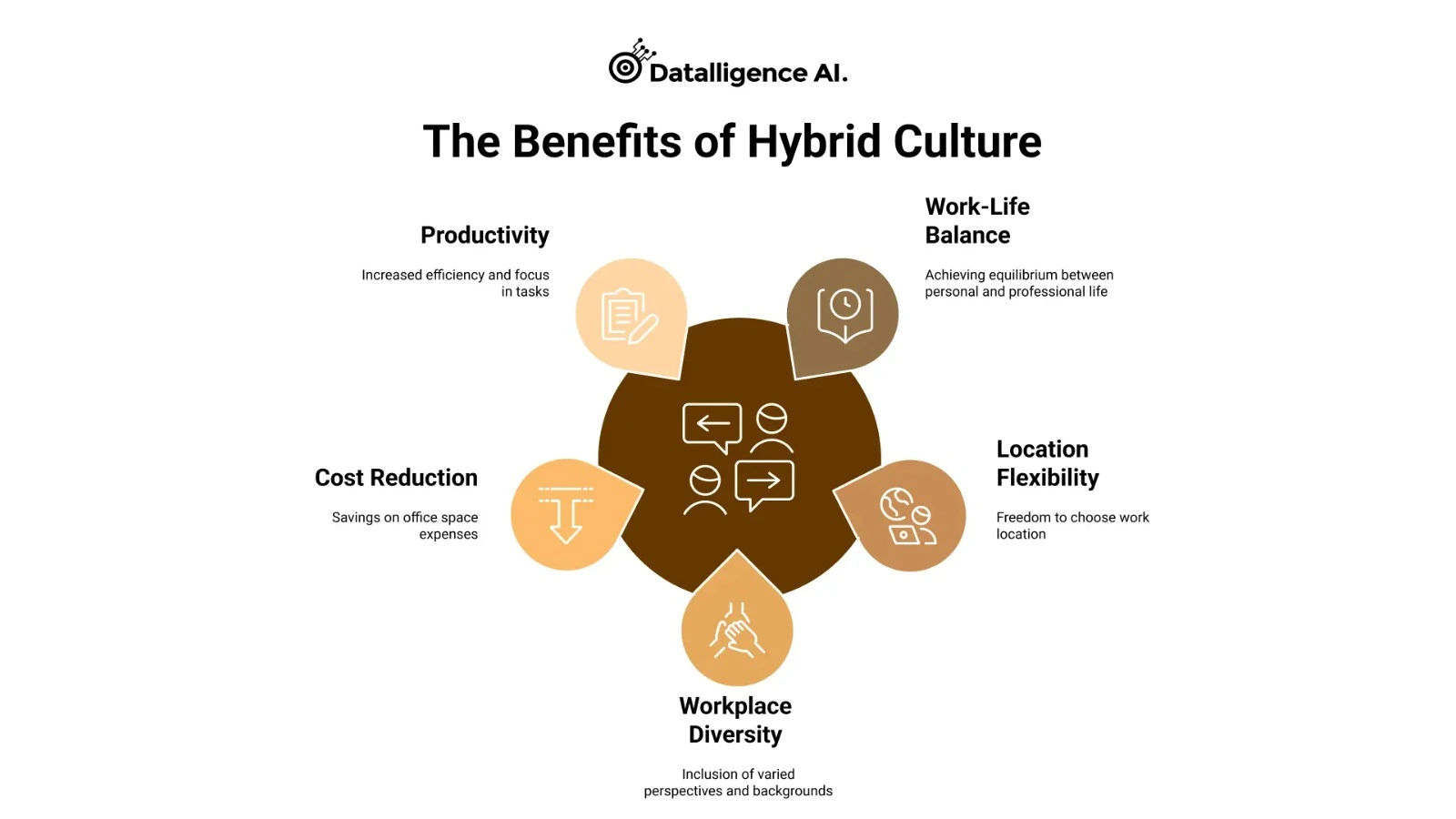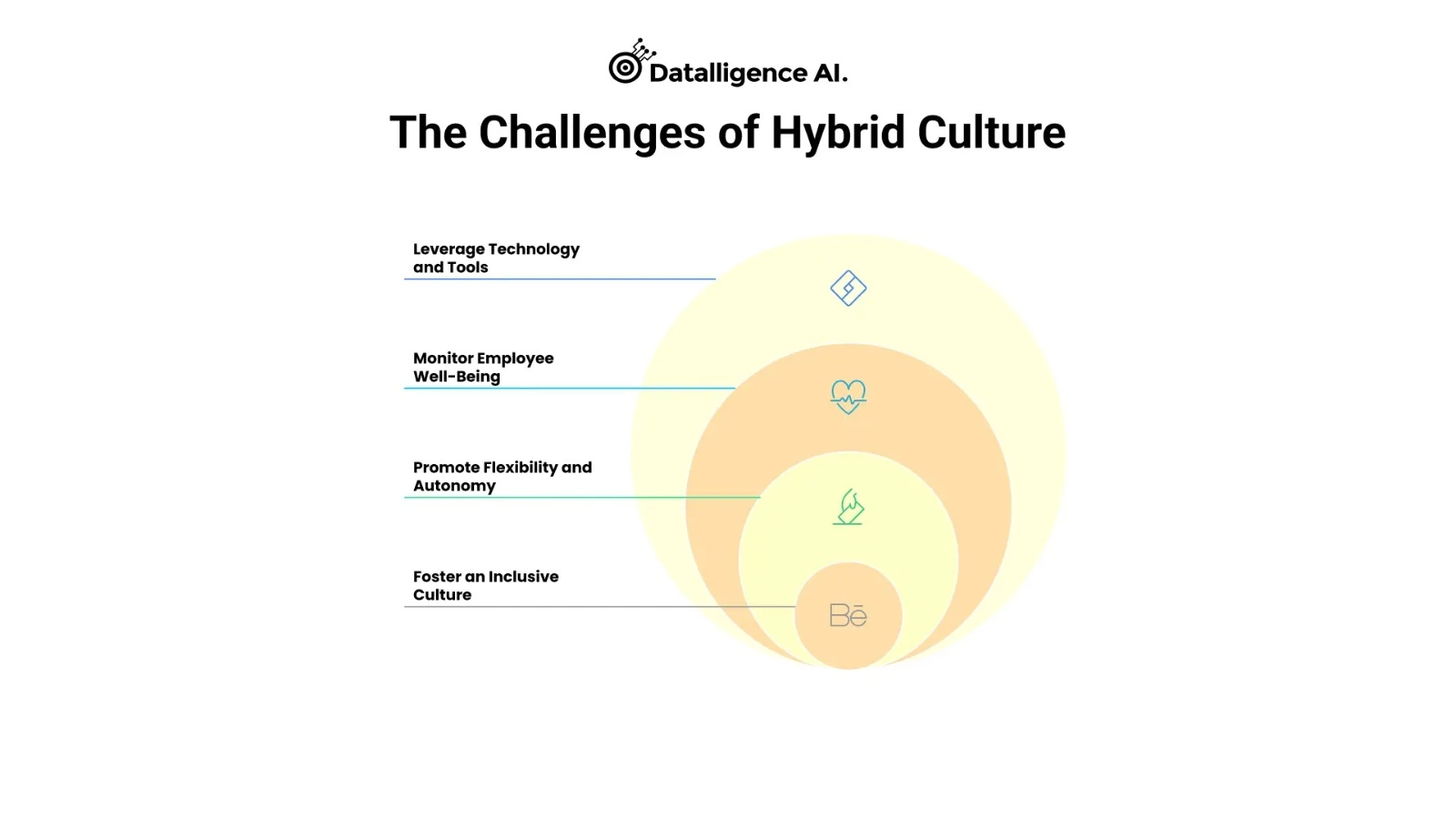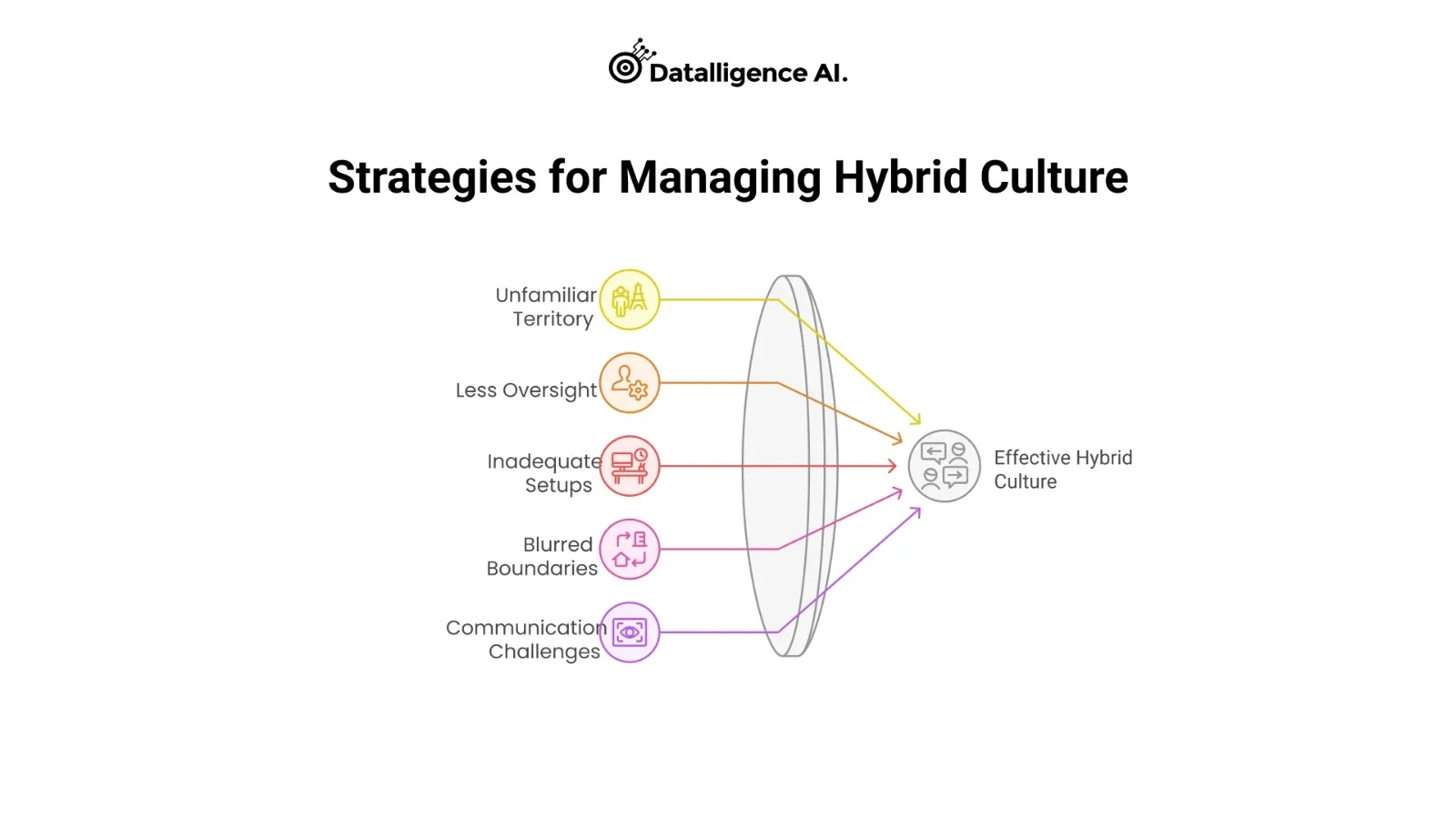Table of Contents
What Is Hybrid Culture?
A hybrid culture refers to an environment that combines both virtual and in-person work arrangements. It offers flexibility and autonomy for employees to choose when and where they work, blending the benefits of remote work with the advantages of in-office collaboration. This model has grown significantly in popularity over the past few years, especially due to the global pandemic that shifted the way organizations operate.
Hybrid culture not only emphasizes physical flexibility but also allows employees to choose their work hours, enabling them to manage work-life balance more effectively. The hybrid work culture offers a pathway to evolving organizational norms and employee engagement, aligning the future of work with changing needs. As companies look for innovative ways to stay competitive, hybrid culture is becoming an integral part of organizational strategies.
The Rise of Hybrid Work: A New Normal
Before the pandemic, remote work was considered a luxury or a temporary solution. However, the shift to hybrid models proved that work doesn’t need to happen within the four walls of an office building. This change has sparked a broader conversation about how work environments can adapt to the evolving needs of employees and businesses.
By adopting hybrid work, employees can decide when to work from home or the office. This flexibility has allowed them to establish a better work-life balance, resulting in increased happiness, satisfaction, and engagement. Moreover, employees can perform at their best, with work locations optimized for different tasks, whether it’s collaborative work requiring in-person interactions or individual tasks that benefit from uninterrupted quiet time at home.
The Benefits of Hybrid Culture
The hybrid work model has unlocked numerous benefits for both organizations and increased employee experience, offering a mix of flexibility and efficiency. Below are key advantages that organizations are seeing from the hybrid work model:

1. Better Work-Life Balance
One of the most significant advantages of hybrid culture is its positive impact on employees’ work-life balance. Hybrid work eliminates the daily commute, which not only reduces stress but also frees up time for personal activities. Employees working in a hybrid environment typically report lower levels of burnout and higher satisfaction with their jobs, contributing to better productivity and greater retention rates.
Moreover, hybrid employees can manage their work schedules according to their personal preferences. Whether it’s taking a break to tend to family needs or having uninterrupted time to focus on professional goals, the flexibility offered by a hybrid culture allows employees to balance personal and professional priorities without feeling overwhelmed.
2. Freedom to Choose Where to Work From
Remote work has proven to be viable for many industries, with some studies even showing that employees may be more productive working remotely than in traditional office settings. Employees in hybrid work arrangements are not bound by geographic constraints and have the freedom to work from anywhere, which significantly increases their job satisfaction and improves work outcomes.
For employers, this model opens the door to a global talent pool, where companies can hire top talent regardless of location. This also allows businesses to expand to new markets with ease, without the need for a physical presence in every region.
3. A More Diverse Workplace
One of the transformative outcomes of hybrid work is the increased diversity in the workplace. With the freedom to work from anywhere, companies can access talent from various cultural, geographic, and socioeconomic backgrounds. This diversification has contributed to a more inclusive workplace that values different perspectives and experiences.
Furthermore, hybrid work has enabled organizations to attract individuals who may not have been able to participate in traditional office settings, such as caregivers, people with disabilities, or those living in remote areas. Hybrid culture helps foster a sense of belonging and inclusivity by offering employees the flexibility they need to thrive.
4. Cost Reduction for Office Spaces
For businesses, hybrid work presents an opportunity to reduce operational costs, especially related to office space. With fewer employees in the office on any given day, companies can downsize their physical spaces, cutting costs on rent, utilities, and office supplies.
In addition, businesses can redirect savings from office expenses into investments in employee wellness, remote work technology, and professional development. This reallocation helps improve overall productivity and employee satisfaction while optimizing the use of resources.
5. Improved Focus and Productivity
Without the distractions of commuting or large office settings, employees working in hybrid environments tend to be more focused. By eliminating the daily rush and time spent traveling, employees can start their workday with more energy and Focus, allowing them to concentrate better and perform at their highest potential.
Hybrid culture fosters a sense of autonomy and trust, encouraging employees to manage their schedules and tasks without the need for constant supervision. This empowerment leads to greater job satisfaction and long-term commitment.
The Challenges of Hybrid Culture
Despite the numerous advantages, hybrid culture comes with its challenges. It’s important for organizations to recognize and address these hurdles in order to fully capitalize on the benefits of hybrid work.
1. Unfamiliar Territory
Although hybrid culture has gained popularity in recent years, it’s still a relatively new concept for many organizations. For some businesses, the transition from a traditional office-first model to hybrid work can be overwhelming. The changes required to make hybrid work effective, from shifting management practices to adapting technology, can take time and require trial and error.
This transition phase can be difficult, especially for organizations with employees who prefer working in physical office spaces or those who have difficulty adapting to remote tools and communication platforms. It’s important for organizations to create a culture of continuous learning to help employees adjust to new norms.
2. Less Managerial Oversight
In a hybrid environment, managers may find it more difficult to oversee teams due to the absence of in-person interactions. While less managerial oversight can lead to greater employee autonomy, it may also result in employees feeling disconnected or unsupported.
On the flip side, the lack of micromanagement often leads to more trust and empowerment among employees, which can positively affect team morale and productivity. To manage this, it’s crucial for managers to strike a balance between providing support and granting employees independence, ensuring that expectations are clearly defined and communication remains transparent.

3. Inadequate Remote Work Setups
Not all employees have the ideal home setup for remote work. Whether it’s limited access to technology, insufficient office space, or distractions at home, employees may struggle to stay productive. Organizations can help by offering employees the necessary tools, resources, and support to create an effective remote workspace.
Some companies may choose to provide stipends for remote office equipment or partner with vendors to offer discounted home office products. Additionally, regular check-ins and employee surveys can help identify gaps in remote setups and ensure that employees have what they need to succeed.
4. Blurred Work-Life Boundaries
One of the drawbacks of hybrid work is that the boundaries between work and personal life can become blurred. With employees working remotely, it can be difficult to “switch off” after work hours, leading to longer workdays and difficulty in maintaining a healthy work-life balance.
Employers can mitigate this by promoting clear communication about expectations for work hours and encouraging employees to establish boundaries. Encouraging employees to take breaks, disconnect after hours, and prioritize self-care can help maintain a healthy work-life balance.
5. Transparency and Communication
Communication is critical in a hybrid work culture, and a lack of transparency can lead to misunderstandings or feelings of exclusion, especially among remote employees. It’s essential to create an environment where all employees feel informed, engaged, and included, regardless of whether they are working remotely or in the office.
Tools like OKR software can help bridge the gap between remote and in-office employees by providing a clear, transparent view of team goals, objectives, and performance metrics. These tools ensure that both remote and office-based employees are aligned and working towards the same goals.
Strategies for Managing Hybrid Culture
To successfully implement and manage hybrid culture, companies must invest in technology, communication practices, and employee support systems. Here are a few strategies to make hybrid work thrive:
1. Leverage Technology and Tools
Hybrid culture relies heavily on technology to enable communication, collaboration, and performance tracking. Investing in reliable tools that support virtual collaboration is essential for creating an inclusive, efficient hybrid work environment. Additionally, companies can explore project management software and OKR platforms to keep teams aligned and on track.
2. Foster an Inclusive Culture
An inclusive hybrid culture ensures that all employees feel equally valued and supported, regardless of their work location. Companies should encourage open dialogue, transparent communication, and employee feedback to ensure that remote employees have the same access to opportunities, information, and career development as in-office workers.

3. Promote Flexibility and Autonomy
The success of hybrid work lies in the flexibility it offers. Encouraging employees to have control over their work schedule and environment helps them perform at their best. Leaders should support flexible work policies that allow employees to manage their time and workload effectively.
4. Monitor Employee Well-Being
Employee well-being is a crucial aspect of hybrid culture. Companies should prioritize mental and physical health by offering wellness programs, access to counseling services, and encouraging healthy work habits. Regularly checking in with employees, conducting surveys, and tracking performance can help organizations address any challenges employees may be facing.
Conclusion
Hybrid culture is here to stay, and while it comes with challenges, it offers significant benefits for employees and employers alike. By offering flexibility, improving work-life balance, and enabling a more diverse and inclusive workforce, hybrid culture is reshaping the future of work.
Organizations that adapt to this new way of working and invest in the right tools and strategies will be better positioned to retain top talent, increase productivity, and create a collaborative work environment that drives success for all stakeholders.
As businesses continue to navigate the complexities of hybrid work, it is essential to embrace change, focus on employee needs, and make informed decisions that support long-term growth











